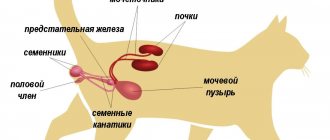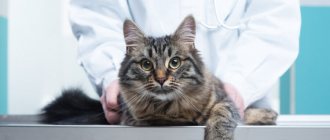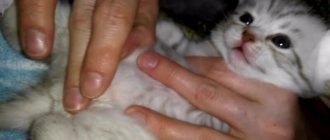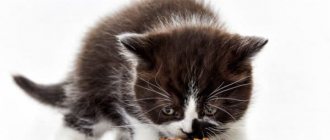Veterinarians note readiness for mating already at the age of 6-8 months, both for males and females. However, sexual maturity does not always depend on age; it is important to monitor the animal. Sometimes puberty can occur earlier or later by 1-3 months.
Feline fertility is known - 3-4 pregnancies per year. The term for one is only 60-65 days. Each individual can bring 3-8 kittens.
Features of sexual hunting
From 8 months the cat is considered sexually mature. If the male does not live in a closed room (apartment) and has free access to the street, during this period he begins to disappear from the house for a long time in search of a sexual object. The owners will immediately understand that their pet has grown up - during the onset of puberty, he begins to meow frequently at night.
The behavior and character of the cat changes, it may become more aggressive. Sexual activity among representatives of the cat world is well expressed. If a pet does not have access to the street, it can imitate sexual intercourse using soft toys and wool clothing. Every time the cat will react violently if a sexually mature female is next to him. If a pet lives in a private home, the owners need to try very hard to keep it from escaping.
For the first sexual intercourse, a sexually mature cat will always choose an experienced female who has already given birth.
If mating occurs in a cat without sexual experience, the owners of the animals should bring them to mating no more than once a month. When they become more experienced and learn to behave appropriately, mating can be carried out 2 times a week.
How to determine pregnancy
The main symptom is the immediate disappearance of sexual heat . If the estrus does not stop, the cat does not become pregnant.
An indirect indicator is behavior change. The cat stops screaming, becomes affectionate, rubs against its owners all the time and demands attention. But it is only possible to determine conception in the early stages with high reliability using ultrasound.
From the third week, some external changes appear: the nipples swell and acquire a bright pink color. The cat eats a lot and with appetite, gains weight and sleeps constantly.
A pregnant cat moves little and sleeps a lot
In the fourth week, you can carefully palpate the lower part of the tummy. Small compactions can be felt there. This procedure should be done as gently as possible so as not to cause pain to your pet.
Possible difficulties
Each cat has its own character. Features of behavior: fearfulness, aggressiveness, arrogance - can interfere with successful mating.
If the cat is afraid of the cat and wants to hide, you can leave them in a room where there are no hard-to-reach places, and put a carrier in which the cat will feel safe and calm.
The size of the partners matters. If the cat is much larger than the cat, and he has short legs, he will not be able to jump on her or reach the vaginal opening.
Cats tend to fall over on their side at the most critical moment, and it is more difficult for the cat to cover it. If the owner is present during the mating, he can try to hold the cat, but this must be done carefully so as not to scare the cat away.
It happens that during mating, the denticles on the cat’s organ tear out the hair from the cat’s body and fall into a ring. Usually the cat is a good licker, but sometimes he cannot remove it himself, and this makes copulation difficult. The owner must ensure that this does not happen and remove the ring of hair himself or contact a veterinarian.
In some cases, partners simply don't like each other. If a cat had a bad experience with a cat of a similar color, or such a cat scared him in childhood or scratched him, then by association he will not want to make contact. There are cats that choose one partner and refuse to mate with others. You can try to choose a cat with a similar exterior, but it is not a fact that the idea will lead to the desired result.
An inexperienced cat may not be able to complete sexual intercourse the first time - you need to leave the couple together for a longer time. The same method helps when a cat goes into heat due to stress when moving to a male cat. Just give it some time and the cycle will resume.
During the first heat of the year (late winter - early spring), cats rarely ovulate, even if the cat successfully ovulates it. Therefore, pregnancy does not occur. It is better to wait a few weeks until the second wave of sexual conscription.
To perform sexual intercourse, the cat needs to feel confident and be in a familiar environment, otherwise he will not be able to perform coitus.
The reason for refusal on the part of the cat is low levels of hormones. This is a rather rare case, since cats do not lose the ability to copulate even when their hormonal levels are reduced by half.
False pregnancy
A false pregnancy is a condition in which a cat exhibits symptoms similar to a true pregnancy, but conception has not occurred. The reasons may be mating with a sterile cat, a malfunction in the female’s body, or being near a pregnant or lactating cat. In the latter case, the causes of false pregnancy are psychological, due to the instinct of reproduction.
Ovulation occurs, in place of the egg a “corpus luteum” is formed, which provokes hormonal activity and preparation for the birth of offspring: appetite increases, the belly grows. After two months, milk will be released from the mammary glands, and if there are kittens from another mother nearby, the cat will feed them. This phenomenon is aimed at increasing the survival of the species in the wild, and is more typical of school animals, so it is not as common among cats as in dogs.
False pregnancy is not a disease. Manifestations are mitigated by sedatives and mild hormonal medications prescribed by a veterinarian. However, regular symptoms negatively affect the cat’s psyche and character, as well as healthy hormonal levels. Therefore, in such cases it is worth considering complete sterilization.
How does a cat behave during its first sexual experience?
If cats mature for procreation at the age of 8 months, and their sexual maturity is pronounced, then in cats everything is a little different. They mature by 9 months and, unlike cats, do not show aggression, but, on the contrary, become overly gentle towards their owners.
A cat that has started walking is strikingly different in its manners - it will walk in circles around the male, fawn over him, and its poses will be quite specific. A cat may mark its territory in the house with urine.
Sexual activity among representatives of the cat world varies and depends on the breed. Cats living at home have a shorter period of sexual activity than indoor cats. The estrus period also depends on the time of year. In winter it lasts no more than 5 days, in summer – several weeks.
During the first intercourse, the cat will behave passively. Some individuals may not allow the cat to approach them at all for the first time, showing increased aggression. Mostly Sphynx and Scottish cats behave this way. The possibility of childbearing remains in females up to 8 years.
Optimal period for first mating
The first time a cat comes into heat is between 7 and 9 months of age, sometimes it can happen a little earlier or later. In the future, it can be repeated again after 14 - 25 days.
This is influenced by the breed of the animal, as well as the living conditions and proper nutrition. However, at such an early age, the cat’s body is not yet fully formed; the growth period is not yet over. Psychologically, the animal is also not ready for procreation, so the cat should not be mated for the first time during the first heat. In some cases, this can lead to difficult childbirth, death of offspring, or further infertility of the animal.
Cats reach final sexual maturity between 1 and 1.5 years. This age is considered the most suitable for the first mating. If you are determined to start breeding kittens, then mating a cat for the first time will best take place during this period of time.
Estrus, main signs
The entire estrus period can take from 5 to 10 days. On the first and second days, the cat's behavior changes; it may become agitated, more affectionate, or aggressive. Often she begins to rub against her legs, furniture and various things. The gait may noticeably change: the hind legs are slightly bent, the tail is raised and the lower back is slightly arched. At this stage, the cat will not allow her boyfriend to approach her.
Over the next 3-6 days, the cat begins to meow loudly, calling for the cat; if you stroke her in the sacral area, she takes a certain pose. The tail moves to the side, raises the croup and falls on the front paws. During this period of sexual heat, the animal's appetite may also decrease significantly and the number of urinations of the animal may increase.
As a rule, in order to avoid exhaustion of the cat’s body, felinologists recommend breeding cats no more than three times in two years.
Puberty of a cat
The first signs of sexual maturity in a cat appear between the ages of 8 and 10 months. First of all, changes occur in the pet’s behavior:
- the kitten’s cheerfulness and playfulness may give way to more aggressive actions;
- in the evening and at night, the cat meows annoyingly or even screams heartbreakingly, thus inviting females;
- begins to mark the territory with a strong-smelling secret, thereby indicating that this is his possession;
- tries to use various soft things to satisfy his sexual needs.
The first mating of a cat should occur only after he has fully reached puberty.
The onset of this period may vary slightly in different breeds, on average it is from 1.3 to one and a half years old. Unlike cats, cats are ready to mate all year round, but with the arrival of spring the desire to procreate becomes stronger.
In order for the mating of a cat to be successful for the first time, it is better to select an experienced partner for him. However, even a couple of untied animals often cope with this task quite well. Do not forget that the reproductive instinct is very strong and is one of the basic natural needs.
Behavior of a cat during estrus
Unlike dogs, in which estrus is signaled by bloody vaginal discharge, cats do not have this symptom. But the behavior of cats changes so dramatically and becomes specific that the owner can easily determine that the pet has entered the active sexual phase:
- Becomes more affectionate, following on the heels of the owner. If the owner is a man, he begs for attention and tenderness from him.
- Spends most of its time in motion, rubbing against furniture and the legs of its owners.
- Takes a specific pose - raises its tail, leans on its hind legs, lifting its pelvis up as much as possible. In this position he can move around the room, backing away.
- Either he stops eating anything altogether, or his appetite decreases significantly.
- He asks to use the litter box more often, as the urge to urinate becomes more frequent.
- It meows more and more often, gradually the usual meowing is replaced by extremely unpleasant, heart-rending screams, which are very difficult for the owners to endure.
Estrus lasts for 5-6 days and repeats every 15-20 days. The presence of the above-described signs is the standard course of estrus in cats, but it also happens that the stage of sexual activity occurs without pronounced signs, this is the so-called latent estrus. The owners will only be glad that their pet lacks open sexual activity, but for breeders this feature of the female can be a real problem.
Gulena cat: all the subtleties of the process
There is an opinion that a cat wants a cat in the spring, or more precisely, in March. And it is true... in relation to the “correct” cats living “in nature”. Natural laws tell them to walk in the spring, feed their offspring in the warm season, and in the cold, think only about survival. Unfortunately or fortunately, the sleek, mustachioed pets who live in our homes look down on this opinion. A sweet life and a good diet lead to the fact that they are ready to reproduce throughout the summer and autumn months, and even winter.
At what age does a cat start asking for a cat?
What time do cats start walking? It depends on its breed: usually a cat begins to ask for a cat for the first time in the sixth to tenth month of life. However, despite the onset of puberty before the age of one year, she is not always able to give birth to healthy babies at this time. If a cat wants a cat for the first time, it is advisable not to let them meet at least until the age of one and a half years.
Signs of estrus in a tailed “bride”
What signs in an animal's behavior indicate that a cat wants a cat? There are a lot of them, and it’s difficult not to notice the signs that a cat has gone on a spree:
- the cat screams both day and night, trying to run away from the house;
- cannot stay in one place;
- cuddles up to people and rubs against objects;
- calm cats become aggressive, and vice versa;
- rolls on the floor, lifts its tail up or to the side, tramples with its hind legs, as if squatting on them;
- loses appetite or almost refuses to eat;
- noticeable discharge from the genitals;
- urination becomes more frequent.
How often does a cat ask for a cat?
How many days does a cat walk? The duration of her estrus varies from person to person. But the end of this period, when the cat has gone on a spree, does not mean at all that the owners can relax for a long time: if the “bride” did not manage to meet the “groom”, screaming and rolling on the floor can resume after a week or two. And to the question “how many days does the cat ask for the cat?” the exhausted owners answer: “all 365 in a year!” How this looks in practice, look at the video (Alexey Karasev).
How long does a cat walk?
How long does the cat ask for the cat? The duration of estrus is usually from 7 to 20 days. If the “bride” does not become pregnant, then the “wedding requirements” will be repeated every 14-21 days until she is expecting children or the resting season begins. Occasionally, a third option is also possible, the so-called false pregnancy, which postpones the appearance of a new period when the cat wants a cat.
Stages of heat
The estrus process can be roughly divided into four stages.
- The first is called proestrus. It lasts from 1 to 4 days and is characterized by the relative calm of the animal. The beginning of the period when the cat went on a spree is indicated only by quiet throaty meows and obsessive caressing of the owners. The tailed cat is not yet ready to meet a roaming cat.
- The second period, estrus, can last 7–10 days. The female begins not just to scream, but to scream at the top of her lungs. When you stroke her back, she crouches, moving her tail to the side. This means they are ready to mate. If you want to let her have a kitten or several, it is better to bring a male on the 3rd-5th day of estrus.
- In the third period, metestrus, which lasts from 3 to 12 days, the pet that has walked with the “groom” will drive away all applicants. When fertilization does not occur, a false pregnancy may begin, very similar to the real one, but not ending in childbirth. True pregnancy in your pet lasts 60–70 days.
- In the last, fourth period, called anestrus, she calms down.
Mating cats - features and stages
It is impossible to predict in advance how the first acquaintance between a female and a male will go. Animals may immediately like each other, or they may show unmotivated aggression.
In order for pets to become friends faster, mating should be carried out in a separate, closed room.
Moreover, in a prepared area there is a greater chance that they will find a common language.
First, a container with a cat is brought into the room; she needs to be left alone for some time so that she becomes familiar with the new conditions. Only after the cat has studied everything and calmed down can the male be brought into the room. An indicator that mating will take place with the expected result is normal, typical behavior of animals. If a cat immediately began to show aggression towards each other, it is unlikely that their acquaintance will lead to anything.
If the cat likes the male, a short period of flirting begins. The animals exchange greetings, after which the cat, after petting the cat several times, allows him to come closer to her. If the female does not like the partner chosen by the owners, she will begin to behave aggressively: she will hiss and growl, and may even bite a cat who tries to come closer to her. Owners must monitor how animals behave. If aggressive behavior occurs, pets should be immediately separated and isolated.
Act of intimacy
As soon as the seals have gotten used to each other, got acquainted and exchanged greetings, after a short sexual foreplay, the female allows the male to approach her, making it clear that she is ready for sexual intercourse by standing in a specific position - with an emphasis on her hind legs, raising her pelvis and tail high . The cat approaches the female from behind, digs her teeth into her nape, and hugs her from the sides with her front paws.
The actual process of intercourse lasts very quickly, with instant ejaculation. At the same time, the cat will purr, and the female will scream heart-rendingly (this scream has its own good reasons). After sexual intercourse, the cats separate in a rather specific manner - the cat with a sharp movement jumps away from the female, who in turn hits him with her paw.
After sexual intercourse, the cat’s behavior changes dramatically – it behaves specifically and aggressively. Aggression is explained by the fact that the cat’s penis is rough, and the female experiences unpleasant, painful sensations during intercourse due to the fact that the vaginal mucosa is highly irritated.
Severe pain during sexual intercourse in a cat is also caused by the fact that the scales on the penis dig into the uterus, which is why the cat screams heart-rendingly after the act. But this irritation is necessary in order to stimulate ovulation in the cat, which begins within 24 hours after mating.
If a cat mates for the first time, there is a high chance that ovulation will not occur immediately. After the first sexual intercourse, several more intercourses must occur for the cat to become pregnant, so the animal must be left with the male for several days. Animals can experience up to 10 acts per day.
The owner should not be far from his pets during the mating period. As a result of the rather aggressive and specific behavior of the female, unforeseen situations may arise, so the presence of a person is necessary to come to the rescue in time.
Possible complications
Mating is a difficult event for both animals and their owners. Sometimes this process is accompanied by various kinds of problems, which you need to have a general understanding of in advance so as not to be afraid of them in the future. We will talk about the most common difficulties that prevent fertilization in this chapter.
Disproportionality of partners
In some cases, owners do not guess the size of their pets. This does not happen so often, since mature animals of the same breed, as a rule, have similar dimensions. But, if the female turns out to be significantly larger than the male, fertilization itself often becomes impossible, since the cat’s body ends up on the cat’s back at the moment of failed intercourse. Of course, the owner can try to move the male to the desired part of the female’s body, but such attempts can lead to resistance from both animals.
When mating cats of the same breed, difficulties with dimensions usually do not arise.
If the male turns out to be larger than the female, then during the mating process the cat may receive injuries of varying severity. In this case, the owners can also artificially intervene and help the animals establish contact, but it is advisable, if possible, to avoid this problem and look for a suitable partner in advance.
Falling over a cat
Sometimes it happens that during intercourse the cat falls on its side, which prevents the cat from finishing what he started. In such situations, the only thing that can improve the situation is the support of the owner. It is necessary to be very careful when placing the cat in the correct position, since the presence of a person can cause severe irritation in it.
When collapsing a cat, you need to give it the correct position
It is worth noting that in some cases cats themselves cope well with this problem, fertilizing those cats that lie on their backs or sides.
Cat aggression towards cat
There can be many reasons why a cat fundamentally does not allow a cat to approach her. Most experts advise not to exhaust animals with each other’s meaningless company and to stop such matings before they end in direct conflict.
It is absolutely impossible to predict the compatibility of animals in advance.
If the partner is of particular value, some owners resort to forced ovulation in the cat, achieved through the use of a special probe. After this procedure, the cat will no longer have control over its instincts and willy-nilly let its partner in.
No heat in a new place
It is important to remember that a change of environment is stressful for every pet. Cats react to stress in different ways, and one of these psychosomatic reactions may be stopping the heat. Such manifestations go away on their own as soon as the animal gets used to the new place.
An unfamiliar environment can temporarily disrupt the functioning of an animal’s body.
Therefore, the best thing the owner can do is to give the female time to get used to the new conditions. This can take half a day or a couple of days. In some cases, owners leave the cat until the next heat to eliminate the likelihood of such a reaction from the body.
Rules for choosing a partner and preparing animals
The choice of a female for a male must be approached with great responsibility, since the quality and quantity of kittens, genetic features, and the successful outcome of the mating itself will depend on the correct choice of partners. If the cat has already had sexual experience, it is worth looking at what the offspring from his previous matings were like.
The best choice would be a prepotent animal, since such a partner will be able to pass on the best genetic set to the kittens. To achieve the best litter from mating a cat with a cat, it is recommended to consult a specialist when choosing a partner.
Before mating, animals need to trim their claws so that they do not injure each other. It is not recommended to perform hygiene procedures on pets, much less bathe them using scented hygiene products. Individuals should exude a natural scent, this increases the likelihood that they will be able to make friends, and the mating will take place with the desired result.
It is recommended to carry out mating in the territory of the male.
In order for the female to feel comfortable in new conditions, you need to bring her litter tray, bowls for food and water, as well as food if it becomes known that the cat eats a different type of industrial diet.
The container with the cat is placed in the middle of the room and left with the door open. Forcibly pulling a cat out of such a shelter is strictly prohibited. The female must calm down on her own and begin exploring the territory. If you force a cat out, it may become very frightened and then refuse to leave the container at all.
When mating purebred cats, you need to take into account a number of nuances. So, for example, a fold-eared cat can only happen to a cat whose ears are straight, otherwise genetic abnormalities cannot be avoided in the resulting litter.
Mating of purebred cats
Mating of purebred cats does not differ physiologically from outbred cats, but its goal is not just healthy offspring, but also maximum compliance with international breed standards. Here it is important to carefully select a stud cat, so this concern falls entirely on the shoulders of the cat’s owner.
The cat and the female cat must be of the same breed or similar breeds acceptable for crossing in the international system. For exhibitions, a good pedigree and the presence of champions and title holders are important. Inbreeding is not allowed, as this can lead to stillbirth, defects and mutations.
It is necessary to carefully consider the genetic characteristics of the manufacturer, evaluate the coat, tail length, eye color, and give preference to a cat with an exterior closest to the standard one. It is advisable to breed cats of a similar color in order to consolidate it in the kittens. The exception is white cats, since there is a high risk of manifestation of the hearing loss gene that accompanies the white coat gene.
If a cat has a deviation from the standard, then the cat should compensate for it, but not be the opposite. This means that if a cat has too small ears, this does not mean that you need to choose a cat with huge ears - this will not work. It is necessary to match the breed type.
Breeding British cats
British and Scottish cats are a bit similar. They are often confused by ordinary people, but breeders know all the differences inside out. However, Scottish Fold cats are descended from British cats as a result of a mutation in the ear cartilage, and the genotypes of the breeds are similar. Therefore, crossing them is prohibited - the risk of developing spinal pathologies is very high. British cats are bred only with cats of their own breed.
There are restrictions on mating according to color standards. There are two main groups of colors: black and red. Crossings are allowed only within the group, otherwise the kittens will be rejected. Golden Britons can only be bred with gold, sometimes with silver, and silver only with silver. The same goes for eye color: orange - with golden, copper, amber, green - only with green, the brighter the better. Blues are bred only with blues, but they carefully calculate the future color of the kittens' fur.
The round face of British cats leaves no one indifferent
Features of mating Scottish cats
The breed with folded ears is called the Scottish Fold. The main rule of mating Scots is that they are prohibited from breeding with the British and with their own breed.
Cute Scottish Fold ears
In the litter of a fold cat there are always two types of kittens: Scottish Fold and Scottish Straight. Straight are straight-eared kittens that do not participate in exhibitions and are used only for breeding - to obtain a healthy litter, you cannot breed two fold-eared animals. Otherwise, kittens are born with crooked legs, an abnormally thick tail, and death is possible.
Sphinx mating
Breeding sphinxes is a labor-intensive process. You need to have a good understanding of genetics in order to calculate the likelihood of dangerous mutations in future kittens based on the external data of the parents. The line between standard and deviation is extremely thin. Not all kittens in a litter will inherit the hairless gene; in some it will be hidden.
Since this breed appeared as a result of a mutation, there are frequent cases of the birth of unhealthy offspring. Therefore, hairless sphinxes are allowed to mate with velor or brush sphinxes with short hair, which have the remaining characteristics of the breed: thin long legs, slanted eyes, huge ears, high cheekbones, sharp muzzle with a weakly defined chin.
Graceful thin-legged sphinxes
Breeding cats outdoors
A barn cat, when she begins her period of heat and is ready to mate, secretes a special hormonal secretion, and it is its smell that attracts many males. They find the female, surround her and begin to fight for primacy, engaging in battle with each other. A barn cat has a large choice and chooses the male she likes the most. But, as a rule, the cat that won the fight with other male contenders will participate in mating.
The tactics of a cat are interesting, who at all costs wants to emerge victorious from the battle - by entering into skirmishes with other males, with each victory he becomes closer to his goal. But as soon as the cat glances at him, he feigns complete indifference. When a male conquers a female, he approaches her as close as possible and begins to scream heart-rendingly in her ear. If there was no negative reaction from the cat, she did not run away, but continued to lie in the appropriate position, sexual intercourse begins.
Mating after childbirth
Breeders often make the mistake of putting kitten production on an assembly line that involves too much use of the cat as an incubator. If the owner does not want to harm his pet, he must clearly understand that a female can give birth to offspring no more than 3-4 times in a year. A greater number of annual matings and subsequent pregnancies will only lead to exhaustion of the cat’s body and further problems with the reproductive system.
It takes a cat about sixty days to recover and fatten newborn kittens.
On average, a young cat’s body recovers after giving birth in about a couple of months, after which the female can be allowed to mate again. The following cases are exceptions:
- pathological births occurred in the cat’s life that required the participation of a veterinarian;
- at the moment, for a number of reasons, the cat is in an exhausted state;
- shortly before the designated mating date, the cat suffered a serious injury or illness;
- If there are stillborn cubs in the last litter of a female, it is recommended to postpone the next mating and skip a couple of heats.
In general, we can say that the body of a healthy female is designed for periodic pregnancies, and “preventive” matings only benefit the pet.
What should you pay special attention to?
Owners of purebred animals should take care in advance to select a suitable pair for their pet. To do this, you can contact a club or visit a cat show, where there are many worthy candidates.
- Discuss mating conditions in advance to avoid any misunderstandings in the future
- Both animals must have all their vaccinations and deworming no later than two weeks before mating;
- Make sure there are no various diseases (fungal, infectious, etc.), as well as skin parasites;
- On the eve of mating, be sure to trim the claws to protect the animals from causing injury to each other;
- Before mating, you should not bathe your pets, as this may drown out their natural odor;
- The owner of the cat should prepare a carrier and all the necessary things for the duration of the bride’s stay with the cat;
- The cat owner must provide a separate room for the couple and constant supervision for them. You also need to observe the mating process and help if necessary;
- Under no circumstances should you give a cat that you plan to breed in the future hormonal contraceptives, as they can cause problems with the animal’s reproductive system.
Recommendations for successful mating
It is best to mate animals in the first 3 days after the start of estrus.
This is the time that is considered the most favorable for mating, which in most cases ends successfully. If you start mating in the last days, the likelihood of successful conception decreases significantly with each subsequent day. In addition, time will be spent ensuring that the pets find a common language.
Since the mating process is best carried out in the male's territory, the female cat may experience severe stress from being brought into a different environment. And due to changes in the psycho-emotional state, estrus may be temporarily interrupted. To return it, the owner must surround the pet with attention and care, stroke and caress it more often, thereby making it clear that it can feel calm in this territory.
You only need to pet the cat in the tail area so that the person does not use his scent to overpower the natural scent of the animal, which is why the cat may not show proper interest in the female. If the beginning of mating did not go as smoothly as desired, the pets are indifferent to each other, or the female behaves too aggressively and does not allow the male to approach, the animals should be left together for a while so that they get used to each other. It is recommended to feed your pets together, this increases the chances that they will quickly find a common language.
But the female should not stay too long visiting the male. If within 24 hours a cat and a cat are unable to find a common language, they no longer have time for mating, since the female will soon be in heat, which significantly reduces the chances of successful fertilization.
How does mating happen?
On the 2-3rd day of estrus, the cat is brought to the partner, because in its own territory the cat feels more confident and is ready to endure all the whims of the bride.
You should not immediately take the female out of the carrier; she needs to be given time to get used to the new place, smells and presence of the male.
This may take from a couple of hours to half a day. When she stops being nervous and is ready, she will go out to meet the cat herself.
At this time, the partner carefully approaches her, sniffs and makes meowing and purring sounds. Animals should be kept in a separate room so that they are not disturbed by extraneous sounds.
The first mating of a cat and a female cat requires mandatory supervision by the owner of the male. During the courtship process, the cat lets its partner get closer and closer, but then can drive the groom away again with a hiss or a blow of its paw.
The male retreats to a safe distance and begins his courtship again, approaching the bride from one side or the other. The cat periodically accompanies the mating ritual with an inviting meow and takes characteristic poses.
When a cat achieves the female's favor with his courtship, he quickly approaches her and mounts her. He grabs her by the withers with his teeth and clasps her from the sides with his front paws. The cat presses itself to the floor and moves its tail to the side. Sexual intercourse lasts about 10-20 seconds, ejaculation occurs and the cat makes a loud cry.
The cat immediately tries to retreat to the side, because the bride hits him with her paw. After this, the female swings on the floor, and the groom actively licks the genitals. Fertilization of the egg occurs within 24 hours. A cat can make 8-10 such coverings per hour, then a couple gets bored and the animals rest.
One cycle of copulation may not be enough, so the cat remains with the gentleman for 2-3 days so that the mating is guaranteed to be successful.
This is how cats mate for the first time. In the future, this process is not much different from the first time, with the only difference being that an experienced cat feels more confident and calm.











